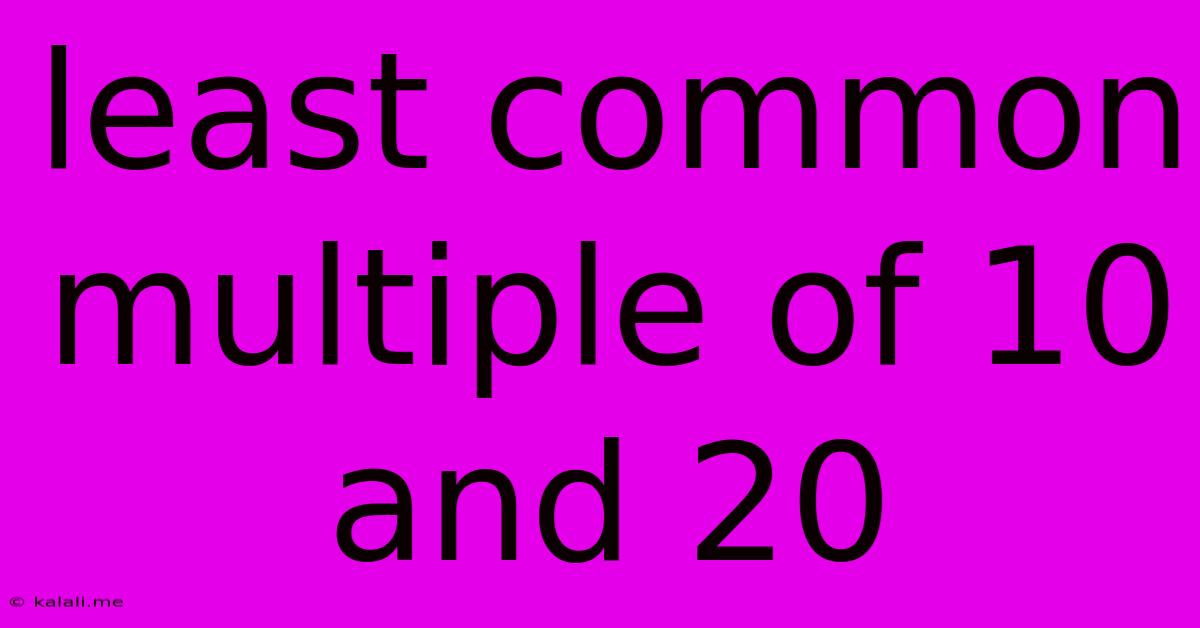Least Common Multiple Of 10 And 20
Kalali
Jun 12, 2025 · 2 min read

Table of Contents
Finding the Least Common Multiple (LCM) of 10 and 20: A Step-by-Step Guide
Finding the least common multiple (LCM) is a fundamental concept in mathematics, particularly useful in simplifying fractions and solving problems involving cycles or repetitions. This article will guide you through calculating the LCM of 10 and 20, explaining the process clearly and offering different methods to achieve the same result. Understanding LCMs is crucial for various mathematical applications and enhances your problem-solving skills.
What is the Least Common Multiple (LCM)?
The least common multiple (LCM) of two or more numbers is the smallest positive integer that is a multiple of all the numbers. In simpler terms, it's the smallest number that all the given numbers can divide into evenly. This concept is closely related to the greatest common divisor (GCD), and both are essential tools in number theory and algebra.
Methods for Calculating the LCM of 10 and 20
There are several ways to calculate the LCM of 10 and 20. We'll explore two common and effective methods:
Method 1: Listing Multiples
This method is straightforward, especially for smaller numbers. We list the multiples of each number until we find the smallest common multiple.
- Multiples of 10: 10, 20, 30, 40, 50...
- Multiples of 20: 20, 40, 60, 80...
By comparing the lists, we can see that the smallest number appearing in both lists is 20. Therefore, the LCM of 10 and 20 is 20.
Method 2: Prime Factorization
This method is more efficient for larger numbers and provides a deeper understanding of the underlying mathematical principles. It involves breaking down each number into its prime factors.
-
Find the prime factorization of each number:
- 10 = 2 x 5
- 20 = 2 x 2 x 5 = 2² x 5
-
Identify the highest power of each prime factor:
- The highest power of 2 is 2² = 4
- The highest power of 5 is 5¹ = 5
-
Multiply the highest powers together:
- LCM(10, 20) = 2² x 5 = 4 x 5 = 20
Therefore, using prime factorization, we again find that the LCM of 10 and 20 is 20.
Understanding the Result: LCM(10, 20) = 20
The LCM of 10 and 20 being 20 signifies that 20 is the smallest positive integer divisible by both 10 and 20 without leaving a remainder. This is crucial when working with fractions, simplifying expressions, or solving problems involving cyclical events.
Conclusion
Calculating the least common multiple is a valuable skill in mathematics. Whether you use the method of listing multiples or prime factorization, understanding the concept and applying the appropriate method will help you solve a wide range of mathematical problems efficiently. The LCM of 10 and 20, as demonstrated, is 20. This simple example provides a solid foundation for tackling more complex LCM calculations in the future. Remember to practice different methods to solidify your understanding.
Latest Posts
Latest Posts
-
Specific Weight Of Water In Si Unit
Jun 13, 2025
-
Memorandum Of Agreement Vs Memorandum Of Understanding
Jun 13, 2025
-
Least Common Multiple Of 27 And 45
Jun 13, 2025
-
What Is The Factor Of 71
Jun 13, 2025
-
10 Is 30 Of What Number
Jun 13, 2025
Related Post
Thank you for visiting our website which covers about Least Common Multiple Of 10 And 20 . We hope the information provided has been useful to you. Feel free to contact us if you have any questions or need further assistance. See you next time and don't miss to bookmark.